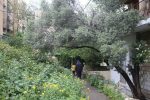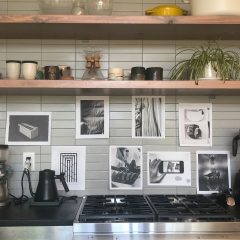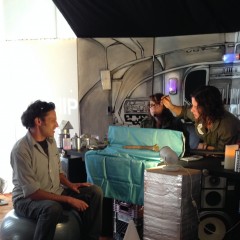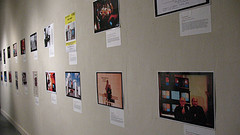
installation shot, detail, of Fred Forest’s retrospective, Art and Society, at Slought.
Fred Forest is a pretty interesting guy. He’s one of the terrific conceptual European artists who practically do not exist as far as American art history is concerned–except that’s not really totally true in the case of Forest, who had an installation, the Digital Street Corner, on the exterior wall of the Bass Museum for Art Basel Miami 2005.
Forest, born in Algeria and living in France, has a retrospective exhibit, Art and Society, at Slought Foundation, a gallery conscientiously contributing to the globalization of American art history by often showing non-American artists well-known elsewhere but not necessarily that well-known here.
At this very moment, the Philadelphia Museum of Art is doing the same thing on a grander scale, with the recent purchases by Contemporary Art curator Carlos Basualdo of non-American artists like Georges Adeagbo, from Benin.
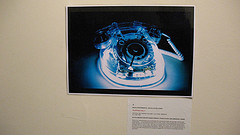
Telephonic Rally, by Fred Forest, with description of the art project beneath the picture of the phone.
Slought also has a preference for politically engaged and theory-driven art. And Forest is a perfect fit for their paradigm.
I went to opening night to catch the artist’s talk, which turned out to be a three-man affair, featuring Forest, Michael Leruth and Jean-Michel Rabaté. Rabate, one of Slought’s trio of curators, translated for Forest, who speaks only French. Leruth, a professor of French at William and Mary, collaborated with Forest in the Digital Street Corner project in Miami.
Rabate, in a bit of hyperbole, called Forest “a dangerous man.” And Leruth, equally hyperbolic, said Forest was in the forefront of information and communication art, and said his early internet work presaged My Space and blogs.
Forest immediately charmed by noting that he had to address two different groups as he spoke, those people in red chairs and those in black ones. “It’s important to be aware of all that makes us who we are,” he said.
Forest, unspoiled by any sort of art education, began by making abstract paintings, but soon projected images onto the paintings. “I was looking for work that could be in constant flux,” he said, through Rabate.
Also a theorist and an author, Forest was the first to sell virtual work in a public internet auction, in 1995, said Leruth. The work was really a merger of art and sociological meddling–and so are many of Forest’s projects.
In 1973, for example, he organized a mock street demonstration, The City Invaded by Blank Space, in Sao Paulo. The participants carried blank signs, not all that dissimilar from Mircea Cantor’s wonderful demonstration and video The Landscape is Changing at the Philadelphia Museum of Art (post here), in which a group of demonstrators carry mirrors in place of signs. The Sao Paulo police arrested Forest for the demonstration, with Forest using his margin of freedom as an outsider during the Sao Paulo Biennale to protest the repressive regime.
Forest said his works are about power. He enters a cultural world and then functions differently than prescribed. Subversive and witty, the work is classicly conceptual, with no tangible artwork.
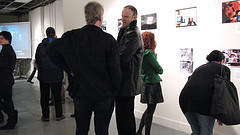
People reading the walls and talking before the talk at Slought.
Of course, this means that all a retrospective can show is documentation, so all you get at Slought are some videos (bring your French along with you), and walls filled with still pictures and lots and lots of words. In other words, Forest is not an artist who should be shown in galleries. His works are each an intervention into a specific culture at a specific time.
I listened to descriptions of a few more of Forests art actions–all amusing and interesting, especially those that elicited governmental reactions, such as Fred Forest President of National Bulgarian TV and The Square Meter of Art.
I love much of his work. So this exhibit is a chance to familiarize yourself with Forest. As is almost always the case at Slought, the exhibit, for all its heavy lifting, is worth the effort. Here are some other ways to get information about Forest and his work:
1) You can listen to the talk, either by downloading it or listening right on that web page. You can also read the relatively readable curatorial statement by clicking on that link on the same web page.
2) If you go to the gallery, check out the videos (French would be helpful).
3) You can read about Forest and his work on line at Web Net Museum. There’s a lot there. His FredForest.org also offers links to descriptions of his projects as well as links to internet projects to participate in. Here’s a link to a live project in which you may participate, Biennale 3000 Sao Paolo, although this one is not as satisfying as some of his prior work.
4) Forest’s most recent book is L’oeuvre-système invisible, Fred Forest, l’Harmattan, Avril 2006.


